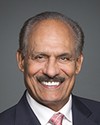Sure. I'm joined today by my colleagues Martin Moen, the director general for North America and investment at Global Affairs Canada, and by Heidi Hulan, the director general of the international security policy bureau.
I'll make the opening statement touching on many of the issues that I think you are looking at. We were given a list of nine wider issue areas. Then my colleagues and I would be very happy to answer questions.
By way of preamble, I was going to say that working with parliamentarians is a critical feature of Global Affairs Canada's outreach strategy in engaging the Trump administration. In fact, the Canada-U.S. Inter-Parliamentary Group has been down in Washington, and the embassy there has been hosting a wide range of parliamentarians individually and in groups as we seek to forge new relations with the Trump administration. We believe that a cross-party, non-partisan approach is the best way to have an impact on American decision-makers and opinion leaders.
The first question in your study is about the overall priorities in Canada's relationship with the United States under the Trump administration. In a certain sense, this was the subject of the Prime Minister's visit to Washington, D.C., on February 13.
The priorities are set out in the joint statement, which is a roadmap for future cooperation between our two countries. It includes five areas of focus, each with concrete commitments. I’ll give you some examples.
The first example concerns the growth of our economies.
When it comes to regulatory cooperation, the Treasury Board Secretariat is leading an ongoing dialogue with senior American government officials. The goal is for the officials to reaffirm the support of the new American administration for the efforts to continue the work and advance regulatory cooperation and alignment opportunities across key economic sectors.
Minister Brison has met with his American counterpart in Washington, and both parties are keen to push this agenda forward.
Another point mentioned in terms of growing our economies was the Gordie Howe International Bridge. This project is under way, and the winner of the call for proposals for the public-private partnership will be chosen in the spring of 2018.
The second area in terms of growing the economies was on promoting energy security and the environment. On energy security, as we know, the KXL pipeline has now received its presidential permit, and several other projects, either pipelines or electricity transmission lines, are at different stages of review in the U.S. process.
Another area mentioned was air and water quality. Environment and Climate Change Canada is working closely with the U.S., and broad co-operation continues on air and water.
Another area highlighted was keeping our borders secure. Part of this is the entry-exit question. Bill C-21 has been tabled and implementation is expected by 2018.
On pre-clearance, Bill C-23 is at second reading and is shortly going to committee. Implementation is still to be determined and we are now also actively exploring with the U.S. how to do joint pre-inspection for cargo.
Another area was working together as allies in the world's hot spots. NORAD was mentioned specifically. The next steps in modernization of NORAD will be tied to the government's defence policy review, which I believe will be coming out shortly.
On Daesh, Minister Freeland attended a Global Coalition against Daesh meeting in Washington, D.C., hosted by Secretary Tillerson on March 22. As you know, Canada is a member of the 68-member coalition to degrade and defeat Daesh.
Finally, on growing our economies, there was the establishment of the Canada-U.S. Council for Advancement of Women Entrepreneurs and Business Leaders. This council is committed to removing barriers to women's participation in the business community and supporting women by promoting the growth of women-owned enterprises to further contribute to overall economic growth and competitiveness.
Let me now say a word about the government's overall engagement strategy with the new U.S. administration and the new U.S. Congress, as well as at the state level.
On January 20, the Government of Canada, provinces and territories embarked on an ambitious whole-of-Canada strategy of engagement and outreach toward the United States. This includes not only the Prime Minister's official visit to Washington in February, but also numerous visits, meetings and other exchanges between senior Canadian government officials and their American counterparts, as well as with political leaders at both national and state levels.
The Prime Minister, cabinet members, parliamentary secretaries, premiers, provincial and territorial ministers, parliamentary committees and other parliamentarians have completed over 70 visits, of which 40 were by 18 cabinet members and three parliamentary secretaries. These figures will continue to grow as senior Canadian government officials embark on outreach to the United States in the coming months.
Our strategy has been to engage with as wide a spectrum of interlocutors as possible from across the United States. We've developed an 11-state outreach program for cabinet ministers. Our goal is to bring our message to parts of the United States that often don't get national-level attention but are nonetheless critical to the success of Canada-U.S. relations.
Let me now turn to some of the pressing commercial issues. Given the administration's “America first” approach, several commercial issues have received media attention recently. We would like to provide you with an update on some of the key files.
On NAFTA, the U.S. administration has clearly noted its intention to renegotiate the agreement, but it has not yet notified Congress accordingly. Canada is open to discussing improvements to NAFTA that will benefit all three NAFTA parties but has not discussed the scope or objectives of any renegotiation. Should these negotiations take place, Canada will be prepared to discuss improvements to the agreement at the appropriate time, as the government has stated. Advocacy efforts are also under way in the U.S. to emphasize the importance of the Canadian market to U.S. exporters, and officials are working with provinces and Canadian businesses to coordinate messaging.
On softwood lumber, Canada continues to believe that it is in both countries' best interests to negotiate a new softwood lumber agreement. Minister Freeland and Ambassador MacNaughton are laying the groundwork with our American counterparts for the eventual restart of negotiations. Canadian negotiators stand ready to re-engage as soon as the United States is ready to do so.
While Canada is committed to negotiating a new softwood lumber agreement, we will not accept a deal at any cost. We want an agreement that is in the best interests of our industry. Also, although we would prefer a quick resolution to this dispute, the Government of Canada is also prepared to defend the interests of the Canadian softwood lumber industry, including through litigation at the WTO or under NAFTA, as appropriate.
Let me touch now on the border adjustment tax.
The concept is currently being contemplated by Republicans in the House of Representatives. We think the measure would be bad for both countries. It would impose extra costs on American companies and disrupt trade at our border. The government, through the Prime Minister, has been raising concerns and soliciting views from a range of stakeholders in the United States, notably in the business community, to help reinforce these points with members of Congress.
I'll touch briefly now on steel. The commerce department in the United States was asked back in January to develop a plan to ensure that steel for the construction, renovation, and enlargement of pipelines in the U.S would be sourced from within the United States. We are preoccupied with this for two reasons.
The first is that the steel industry in North America is extraordinarily integrated and runs on both sides of the border. The second reason that we are concerned about steel is that this is an attempt to determine procurement that is usually done via the private sector. This is not public procurement; this is the government telling private enterprises from whom they should buy. Those things are usually left to commercial considerations. We have made observations in this regard to the Department of Commerce in the course of its regular consultation process, which is ongoing. As I mentioned, my colleague Martin Moen would be pleased to answer questions on any of these commercial issues.
Let me now turn to trilateral relations, which are also a part of your study.
Canada, the U.S., and Mexico have a long history of collaborating as continental partners in the areas of security, commercial relations and competitiveness, the environment, and other areas. Since 2005 the three countries have been meeting for the North American leaders' summit, which is aimed at advancing common policy objectives in many of the areas I just mentioned. The last such meeting took place in Ottawa last June.
While there are uncertainties about the direction of trilateral co-operation since the election of President Trump, there are at the same time early signs that indicate a number of trilateral commitments from the 2016 North American leaders' summit here in Ottawa will continue. I won't elaborate on them—they have to do with the border, energy security, and regional co-operation—but I'd be happy to answer questions on those trilateral dimensions.
In addition, the annual trilateral energy and defence ministers' meetings are being planned for this spring. There's also been some talk of a trilateral foreign ministers' meeting. These meetings, along with the developments in the renegotiation of NAFTA, will provide us with signals as to the future direction of trilateral co-operation.
I'll now talk about foreign policy cooperation.
The Trump administration came to office with a very forthright “America First” approach to foreign policy. This approach overtly places the United States and its interests at the forefront. The approach focuses on economic nationalism, protection of American sovereignty and hard power.
This policy is in distinct contrast with the policies of both Democratic and Republican administrations that have led the United States since the Second World War. These policies emphasized American leadership in advancing democracy and human rights, promoting freer trade, building international institutions, and working closely with allies to advance these objectives.
At this point, it isn't clear how the overarching principles of “America First” will translate into day-to-day policies. Furthermore, many of the senior positions in the administration, such as in the State Department, haven't been filled yet. We're in a very early phase.
Intervening events, such as North Korea's missile test or Syria's use of chemical weapons on civilians, may significantly shape the Trump administration's foreign policy. Canada condemned the chemical weapons attack and fully supported the United States' response.
As I mentioned earlier, my colleague, Heidi Hulan, will be pleased to answer any detailed questions.
Let me end there. I've tried to give you a brief overview of some of the main themes in Canada-U.S. relations right now. We look forward to the committee's deliberations and the eventual report.
We would welcome your questions and comments. Thank you.





